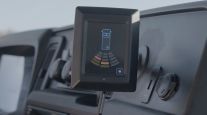Senior Reporter
Collision Avoidance Systems Succeed in NHTSA Field Test

This story appears in the June 20 print edition of Transport Topics.
A yearlong federal field test of 150 Class 8 tractor-trailers equipped with collision avoidance systems had no rear-end crashes, a new National Highway Traffic Safety Administration study revealed.
More than 100 drivers from seven unidentified U.S. motor carriers drove their regular routes in heavy trucks equipped with either Meritor Wabco OnGuard or the Bendix Wingman Advanced crash avoidance systems.
“In over 3 million miles of data, no rear-end crashes of the type collision avoidance systems are designed to prevent were identified,” according to the study, conducted for NHTSA by the Virginia Tech Transportation Institute.
The systems alert drivers to impending conflicts with objects and initiate automatic emer- gency braking.
“Though the systems as a whole appeared to have a safety benefit, false activations were also observed,” the study said. “False automatic emergency braking activations were much shorter, on average, as compared to other AEB activations but could still frustrate or annoy drivers.”
The companies that participated in the study were of different sizes, located in different regions of the United States, hauled different materials and were a mix of day trip, longhaul, and slip seat operations.
“Efforts were made to include owner-operators in the study, as they represent a major segment of the trucking industry; however, no owner-operators agreed to join the study,” NHTSA said.
The 169 drivers involved were not directly questioned about their driving history, experience with collision avoidance systems, technology or understanding of the system operation.
The study did not identify safety-critical events outside of the sampled 6,000 system activations that were tested.
“While fleets report up to an 87% decrease in rear-end crashes and about 89% reduction in rear-end crash costs with the previous OnGuard system, our newer OnGuard Active will be a further improvement,” Meritor Wabco President Matthew Stevenson said in a statement. “We’ll take lessons learned from this study to strive for the prevention of 100% of rear-end collisions, moving forward.”
Fred Andersky, a Bendix executive who works on customer solutions and follows government affairs, said the study showed that collision avoidance technology has come a long way and helps drivers in a variety of potential crash situations.
“I think what was really great about the test is that they really designed it to be a real-world test,” Andersky told Transport Topics. “But as we’ve always talked about, collision mitigation doesn’t replace the need for safe drivers and safe-driving practices.”
Andersky said that the tests were conducted with earlier-generation systems that since have been improved with the company’s Wingman Fusion system.
“The fact that they saw good results, even with the previous-generation technology, really speaks well for what the expectations can be for the next-generation technology,” Andersky said. “The only negative that came out of the test is that there still is an issue with false alerts and false interventions.”
The testing systems were developed by the Virginia Tech Transportation Institute to collect continuous video of the forward roadway, video of the driver’s face, crash avoidance systems activations and vehicle network data whenever the trucks were in motion.
NHTSA said that fleet safety managers reported they would recommend crash avoidance system technology.
“While the CAS user experience can be improved, and some activation types were found to be less reliable than others, the results from this study suggest that the overall systems work as intended,” researchers said.
“We are very positive about the systems,” said Jim Boyd, manager of fleet technical services at Southeastern Freight, a less-than truckload carrier based in Lexington, South Carolina, that deploys Bendix and Meritor Wabco collision avoidance systems on some of its fleet of 3,000 tractors.
“We think that they certainly help fleets mitigate crashes,” Boyd said. “They might not completely help you avoid a crash, but they certainly can take some of the speed out of a crash. We feel like our success with the systems has already made a positive impact on accident reduction.”
Researchers said that results of the study suggest that the highest-priority activations tend to go off in the most urgent situations, which may help the driver respond appropriately.
“Lower-priority activations tend to be advisory and may be useful for drivers in adjusting their general behavior, rather than in reacting to specific situations,” the study said.
Researchers also said that system activations prior to safety critical events were most likely to occur in medium traffic-density conditions.
Steve Handschuh, CEO of the Motor & Equipment Manufacturers Association, said the NHTSA report is consistent with a study his organization published last year on the benefit of advanced driver-assistance systems and collision avoidance systems on light-duty vehicles.
“This is good news,” Handschuh said. “MEMA has long advocated for public policies to more quickly deploy these life-saving technologies.”


